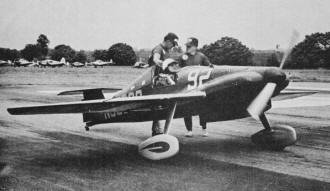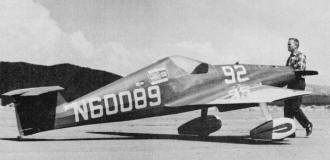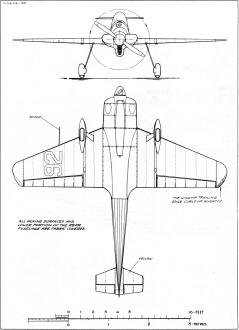|
Website visitor Gareth P. wrote
to request that I scan and post the article for Falck's Special "Rivets" racer for
Formula I events. The article is a documentary on the airplane and its designer
/ builder / owner, Bill Falck. As such, it does not include plans for building a
model; however, it does include one of uber draftsman Björn Karlström's 4-views
that could be used for creating a set of plans. BTW, the AMA plans service has 5
version of Rivets building plans
if you want to go the easy route.
Rivets
The plane to beat in Formula I Races is Bill Falck's 'Special.' Sixteen wins
- 20 firsts and seconds since 1964!
by Don Berliner

Bill Falck's Rivets.
"Rivets" is almost as fast as the GeeBee! And a lot more streamlined! In its
day, the glamorous GeeBee Super Sportster was speed personified. If it was running
right, nothing could keep up with it. It is easily the most famous American racing
airplane of all time. Yet it was crude and clumsy compared with "Rivets."
The strange-looking Falck Special No. 92 has been clocked twice at 231 mph around
a three mile course, even though it has a little 201 cu. in. engine normally rated
at 100 hp and certainly producing less than 150 hp. The great GeeBee, in its prime,
was clocked at 253 mph around a much faster five mile course - pulled by a huge
1340 cu. in. engine which developed at least 800 hp.
How has Rivets designer/builder/owner/ pilot Bill Falck done it? He has combined
post-GeeBee engineering with two decades of personal experience and a lot of extremely
hard work. His racer has the least frontal area of any machine in its class. Takeoff
acceleration has been sacrificed for maximum speed on the straightaway. He has accepted
the poor flying qualities of a steeply swept-back wing for the extra visibility
which enables him to see the pylons while flying higher than anyone else, and thus
staying out of traffic.

Bill Falck's Rivets, side view.
As important as absolute speed is in air racing, consistency is even more so.
What good is a super-fast airplane if mechanical problems keep it on the ground
most of the time? The classic GeeBees (R-1 and R-2) won but a single Thompson Trophy
Race between them, despite their speed. Rivets, on the other hand, has won no fewer
than 16 Formula I races. At one time, Bill Falck had an unprecedented string of
eight straight wins. In the 23 races they have flown since the sport came back in
1964, they have placed first or second in 20!
With the Formula I class being the most competitive of all during its 24 years,
such a record of success is all the more surprising. Some of the finest pilots who
ever flew the pylons have tried to dislodge Falck and his model from their place
in victory lane, but no one has been able to do it consistently. "Shoestring" pilot
Ray Cote has come the closest, beating them at Reno in 1968-69-70, but Cote works
all year long for that one race, while Falck is there every time the flag is dropped
for a Formula I race.
These winning ways didn't come quickly or easily. There were slow and unhappy
days, for Bill Falck knew no shortcuts to victory. When he first brought Rivets
out in public for a race many laughed, for it was a funny-looking airplane. The
bulging canopy extended all the way to the spinner, and the airplane flew around
the pylons with its nose in the air. Bill had built his racer so he could fly it
while lying flat on his back, but this streamlining idea was declared unsafe shortly
before his first race in No. 92, and the hurried modifications weren't quite right.
He still placed second in the Consolation Race, though his speed was only 142.5
mph.
Rivets underwent the first of several major changes which were destined to turn
an also-ran into a winner for the following year - 1949. As operator of the small
Warwick Airport in New York, Falck had a lot of time on his hands when snow made
his dirt runway useless, so he put the time to good use by methodically re-working
his airplane, piece by piece. The first area to get a good going over was the canopy,
and the original "plastic bathtub" was replaced by a clean canopy made from pieces
of Aeronca Champion windshield. Months of hard work paid off to the tune of 20 mph
and first place in the Consolation Race at Cleveland.
Yet Falck and his Rivets were a full 15 mph behind the winners, and so few people
paid attention to them, except in the pits where "Willie" was becoming recognized
as a very competent student of racing. But they were no particular threat to people
like Steve Wittman and Bill Brennand and John Paul Jones, who were doing the winning
in those days.
In the time between the last of the old Cleveland Races in 1949, and the 1951
Detroit meet, Falck completed the single most important modification to his racer
- the change that was soon to make it winner. He designed, built and proved the
complicated set of plumbing under the sleek new cowl that gave the model a sound
like it had several extra cylinders. Basically, it was an updraft cooling system
with tuned exhaust pipes, all exiting through an augmenter in the tunnel underneath
the cowl. Far more efficient than the usual, simple exhaust pipes and cooling-air
outlet, it enabled Rivets to advance from consolation to final races. This happened
first at Miami in 1950, when they placed 7th at 173 mph, and soon became a matter
of habit.
Specifications:
Dimensions: Length - 18' 0" Wingspan - 17' 9" Wing
Area - 66 sq. ft. Wing Airfoil - modified M6 Aspect Ratio - 5.23-1 Empty
Weight - 635 Ibs. Normal Loaded Weight- 855 lbs.
Performance: Maximum Speed (est.) - 255 mph. Landing
speed - 70 mph Cruising Speed - n.a. , Cruising Range - n.a.
(n.a. - not applicable, as the airplane is never flown
cross-country.)
Getting into the finals was a step in the right direction, but hardly the same as
winning. Falck's first win was a dramatic one, and set the theme for many races
to come. At a small race in Chattanooga, Tennessee, in the spring of 1952, Bill
qualified second following the great Wittman and then shared preliminary heat wins
with him. In the 12-lap finals, Wittman got off to his usual fast start and Falck
to his usual slow start. Lap by lap, Rivets gained on the famous Bonzo, until it
was clear to everyone that only time or luck could keep that upstart with the funny
airplane from pulling the upset of the year. For Wittman, there was too much time
and no luck, as Falck passed him on high with a couple of laps to go and won by
the narrow margin of 186.95 mph to 186.79 mph. A winter spent hammering out a fancy
set of new wheel pants was time well spent for Bill Falck.
Racing soon slipped to the level where it was little more than a friendly game
played by Easterners at such places as Niagara Falls, Oshkosh and Ft. Wayne. Of
11 such races held from 1954 through 1960, Falck and his racer won five, were second
in three, and third in two - by far the best overall record of the period. Moreover,
they hung up their first really important record by qualifying at Niagara Falls
in 1956 at 208.81 mph, five mph better than the old mark. It was all a little sad
though, for the great performances were before small crowds and received almost
no publicity. Even the great story of Rivets being reduced almost to ashes by a
fire in 1956 and then coming back to win the big race of the next season went almost
unnoticed.
When racing came back at Reno in 1964, Bill Falck was not exactly an instant
hero. He didn't even fly in that first race, but he won a photo finish with Bob
Downey at St. Petersburg, Florida the following winter. In 1965's big races, his
best were seconds at Reno and Las Vegas. He then repeated his win at St. Pete in
1966 and charged off on the greatest winning spree the sport has ever seen. Victories
at Frederick, Maryland and Reno gave him the first Formula I National Point Championship.
Winning all three races in 1967 gave him a second championship. In 1968, two firsts
and a second meant yet a third championship. In 1969, it was three firsts and a
second, and championship number four. They combined wins at Ft. Lauderdale, Florida,
and Wilson, North Carolina, and a second at Reno for a fifth straight national title
in 1970, along with a qualifying record of 231.26 mph.
As the 1970's dawned and the ranks of Formula I began to swell with more new
racers than had ever been seen before, there were increasing chances that new airplanes
would come along to take the place so long held by Rivets. Its excessive weight
- 635 lbs. vs. 520-550 lbs. for most of the other fast ones - was a serious handicap.
Being more than 20 years older than when he built No. 92, Falck seemed unwilling
to start over on a new racer, though it was widely recognized that he had the skill
and knowledge to build a new airplane that would be as unbeatable as Rivets had
been for the past decade.
But, until someone can consistently beat him at more than one race site, Bill
Falck will no doubt continue to terrorize Formula I with possibly the finest racing
airplane, pound for pound, that has ever flown.
Note: Our special thanks to Eddie Fisher, of Birdland Airport, Leroy, Ohio for
suggesting this airplane.

Rivets 4-View, Sheet 1
<click for larger version>

Rivets 4-View, Sheet 2
<click for larger version>
Björn Karlström Drawings:
Posted October 9, 2012
|



